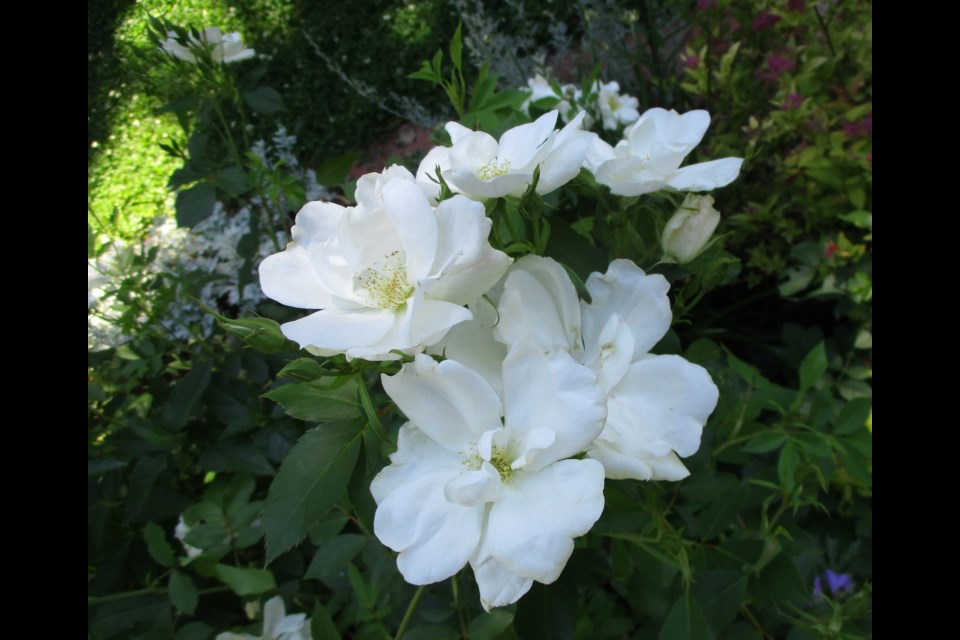Here are some rose cultivars (cultivated varieties) that have done well in my garden and are well over 20 years old. In other words, they are tried, true and hardy.
‘Morden Fireglow’ has done exceptionally well, sandwiched in between two cedars that have outgrown their space. The unique orange-red flowers with very narrow flower buds, the glossy foliage and the form all resemble that of a tea rose. It does die back sometimes to the ground in winter but always bounces back. In Growing Roses in Saskatchewan, Brian Porter mentions that it is susceptible to blackspot and is only moderately resistant to powdery mildew. This has not been my experience. Neither of these diseases have developed. Perhaps it likes its location, just outside the range of my watering system, and therefore in a relatively dry area of the garden.
‘Morden Snowbeauty’ is a sprawling rose bush, with large, white semi-double flowers in small clusters. It is about a meter tall with a spread about twice that size. The lower branches tend to lie near ground level and are quite prickly. I have planted it amongst other tall perennials, so it is more upright in appearance. My daughter, however, had it planted too close to her walkway and dubbed it 'The Ankle Biter'. Because it tends to sprawl, branches at ground level will often root. If you separate them from the mother plant, they can be moved to other locations in your yard. It dies back some years but is quick to rebound. New growth in spring tends to be very tender and in my yard a bit susceptible to insect damage on the lower branches. Introduced by Lynn Collicut and Dr. Campbell Davidson, I believe it is the only white rose released out of the Morden Rose program.
‘Cuthbert Grant’ is another favourite because of its large, deep red, velvety flowers. It was introduced by Henry Heard Marshall. Cuthbert Grant was a Scotsman who in 1793 established Fort La Souris, later known as Fort Assiniboine. It was his son, also named Cuthbert Grant, who is credited as the founder of the Metis nation and its leader in Saskatchewan (before Louis Riel), that the rose commemorates. It blooms at the beginning of summer and will repeat bloom near the end if properly deadheaded. This year it had severe dieback. I thought it might not survive, but by the middle of June, it put out its first spray of flowers.
You may be lucky and find some of the following heritage roses at your local nursery. Many are no longer in general circulation but are thriving in my yard. What they have in common is a tendency to sucker considerably. Nor are they repeat bloomers. Their maintenance is not for the faint of heart.
‘Dr. Merkeley’ blooms only once in summer. It has double pink, fragrant flowers with densely packed petals. It is a vigorous grower with widespread because of its suckering habit. I planted it in the Heritage Rose Garden in Saskatoon, in a spot where nothing else wanted to live. It requires extensive pruning, which is a challenge sometimes as it has quite sharp prickles that grow back along the stems and hook onto everything. This rose was discovered in Russia and brought to Canada by Dr. Merkeley, a Winnipeg dentist who gave it to Frank Skinner, who introduced it. It probably fell out of favour because of its suckering and sporadic bloom habit.
‘Suzanne’ blooms in spring just after my cherry trees have finished blossoming. The fragrant flowers are light pink. Kept in check with regular pruning, it can be a beautiful addition to the garden. Whenever I mow my lawn, I need to first prune out all the suckers, which appear up to three meters from the mother shrub - perhaps the reason it is no longer widely available. A Frank Skinner rose, was often used by other early plant breeders in their rose development.
‘Prairie Peace’ competes well with my raspberries. Developed by Robert Erskine, its peach flowers never fail to delight in spring. It’s easier to keep in check than ‘Suzanne’, but not by much.
All three of these roses are on display in the Heritage Rose Garden at the Forestry Farm Park in Saskatoon. Unfortunately, they only put on a show in spring, shortly after apple blossom time.
This column is provided courtesy of the Saskatchewan Perennial Society (SPS; [email protected]). Check our website (www.saskperennial.ca) or Facebook page (www.facebook.com/saskperennial) for a list of upcoming gardening events.




